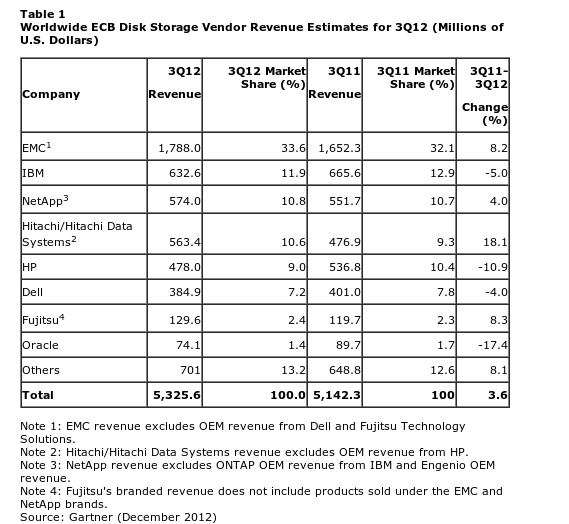 It’s not a great time to be a hardware provider. Gartner reported Dec. 13 that revenues in the storage market rose 3.6 percent to $5.3 billion during the third quarter, year-over-year. That’s the weakest increase in seven quarters. On top of that, third-quarter revenue was down sequentially compared to both the first and second quarters of 2012. At least the storage market managed to avoid the revenue declines of the server market. But storage’s anemic revenue growth hints at a deeper problem: combined, the storage-area network (SAN) and direct-attached storage (DAS) market grew just 1.6 percent in the past quarter—and that’s bad news for a segment that represents around 76.2 percent of the total external controller-based market. The bright spot is the network-attached storage market (NAS), which grew 10.9 percent. Earlier this month, rival analyst firm IDC positioned the external disk storage market as growing 3.3 percent, to $5.9 billion. Total disk storage systems capacity shipped reached 7,104 petabytes, growing 24.4 percent year-over-year. While that’s an important milestone, disk capacity continues to outpace revenues. Without a doubt, the leader of the storage market continues to be EMC, which generated $1.79 billion in revenue, up 8.2 percent from a year ago. Gartner estimated EMC’s market share at 33.6 percent, up 1.5 percentage points from a year ago. EMC’s share is still more than double of its closest competitor, IBM, at 11.9 percent. IBM actually saw its revenues fall by 5 percent to $632.6 million, dragging down its market share a percentage point to 11.9 percent. Gartner, which excluded revenue from IBM and HP, bunched NetApp and Hitachi at third and fourth, with 10.8 percent and 10.6 percent market share, respectively. Both saw positive growth in revenue and market share. Roger Cox, the Gartner analyst who issued the report, issued specific reasons for why some companies succeeded and others failed. Cox blamed global macroeconomic pressures for the weak growth, while also identifying several company-specific issues that contributed to the four companies that outgrew the market: Hitachi/Hitachi Data Systems, Fujitsu, EMC and NetApp. Hitachi, for example, found success with its high-end VSP offering. Fujitsu’s Eternus platform helped it gain share in Europe and Japan. And NetApp’s broad portfolio simply offered what customers wanted, he said. Cox also identified problems: the abrupt Compellent Storage Center and EqualLogic PS Series revenue shortfall, the latter apparently due to changing go-to-market strategies resulting from executive leadership changes, such as storage chief Darren Thomas’ recent departure. HP’s success from its 3PAR products hasn’t offset declines in legacy P9000 XP, P6000 EVA, P4000 SAN and P2000 MSA products, which collectively deteriorated 24.5 percent in the third quarter of 2012 (compared with the third quarter of 2011). As for IBM, Cox blamed “faulty field operation and execution” and declining sales in its DS8000 series, which is closely aligned with System z and Power System server sales, as well as midrange DS5000/3000 and N series revenue. While Gartner’s outlook was decidedly negative, IDC took a markedly rosier view. “The external disk storage system market continues to exhibit steady growth, posting solid third quarter factory revenues of just over $5.9 billion," Liz Conner, IDC’s senior research analyst for storage systems, wrote in a Dec. 7 statement. "End users continue to invest in storage infrastructures despite persistent concerns surrounding global and regional economies. Helping to drive the worldwide market in the third quarter was the double-digit growth in multi-protocol storage architecture and strong demand for upper mid-range and high-end storage." Image: Gartner
It’s not a great time to be a hardware provider. Gartner reported Dec. 13 that revenues in the storage market rose 3.6 percent to $5.3 billion during the third quarter, year-over-year. That’s the weakest increase in seven quarters. On top of that, third-quarter revenue was down sequentially compared to both the first and second quarters of 2012. At least the storage market managed to avoid the revenue declines of the server market. But storage’s anemic revenue growth hints at a deeper problem: combined, the storage-area network (SAN) and direct-attached storage (DAS) market grew just 1.6 percent in the past quarter—and that’s bad news for a segment that represents around 76.2 percent of the total external controller-based market. The bright spot is the network-attached storage market (NAS), which grew 10.9 percent. Earlier this month, rival analyst firm IDC positioned the external disk storage market as growing 3.3 percent, to $5.9 billion. Total disk storage systems capacity shipped reached 7,104 petabytes, growing 24.4 percent year-over-year. While that’s an important milestone, disk capacity continues to outpace revenues. Without a doubt, the leader of the storage market continues to be EMC, which generated $1.79 billion in revenue, up 8.2 percent from a year ago. Gartner estimated EMC’s market share at 33.6 percent, up 1.5 percentage points from a year ago. EMC’s share is still more than double of its closest competitor, IBM, at 11.9 percent. IBM actually saw its revenues fall by 5 percent to $632.6 million, dragging down its market share a percentage point to 11.9 percent. Gartner, which excluded revenue from IBM and HP, bunched NetApp and Hitachi at third and fourth, with 10.8 percent and 10.6 percent market share, respectively. Both saw positive growth in revenue and market share. Roger Cox, the Gartner analyst who issued the report, issued specific reasons for why some companies succeeded and others failed. Cox blamed global macroeconomic pressures for the weak growth, while also identifying several company-specific issues that contributed to the four companies that outgrew the market: Hitachi/Hitachi Data Systems, Fujitsu, EMC and NetApp. Hitachi, for example, found success with its high-end VSP offering. Fujitsu’s Eternus platform helped it gain share in Europe and Japan. And NetApp’s broad portfolio simply offered what customers wanted, he said. Cox also identified problems: the abrupt Compellent Storage Center and EqualLogic PS Series revenue shortfall, the latter apparently due to changing go-to-market strategies resulting from executive leadership changes, such as storage chief Darren Thomas’ recent departure. HP’s success from its 3PAR products hasn’t offset declines in legacy P9000 XP, P6000 EVA, P4000 SAN and P2000 MSA products, which collectively deteriorated 24.5 percent in the third quarter of 2012 (compared with the third quarter of 2011). As for IBM, Cox blamed “faulty field operation and execution” and declining sales in its DS8000 series, which is closely aligned with System z and Power System server sales, as well as midrange DS5000/3000 and N series revenue. While Gartner’s outlook was decidedly negative, IDC took a markedly rosier view. “The external disk storage system market continues to exhibit steady growth, posting solid third quarter factory revenues of just over $5.9 billion," Liz Conner, IDC’s senior research analyst for storage systems, wrote in a Dec. 7 statement. "End users continue to invest in storage infrastructures despite persistent concerns surrounding global and regional economies. Helping to drive the worldwide market in the third quarter was the double-digit growth in multi-protocol storage architecture and strong demand for upper mid-range and high-end storage." Image: Gartner Storage Market Shows Anemic Growth: Gartner
 It’s not a great time to be a hardware provider. Gartner reported Dec. 13 that revenues in the storage market rose 3.6 percent to $5.3 billion during the third quarter, year-over-year. That’s the weakest increase in seven quarters. On top of that, third-quarter revenue was down sequentially compared to both the first and second quarters of 2012. At least the storage market managed to avoid the revenue declines of the server market. But storage’s anemic revenue growth hints at a deeper problem: combined, the storage-area network (SAN) and direct-attached storage (DAS) market grew just 1.6 percent in the past quarter—and that’s bad news for a segment that represents around 76.2 percent of the total external controller-based market. The bright spot is the network-attached storage market (NAS), which grew 10.9 percent. Earlier this month, rival analyst firm IDC positioned the external disk storage market as growing 3.3 percent, to $5.9 billion. Total disk storage systems capacity shipped reached 7,104 petabytes, growing 24.4 percent year-over-year. While that’s an important milestone, disk capacity continues to outpace revenues. Without a doubt, the leader of the storage market continues to be EMC, which generated $1.79 billion in revenue, up 8.2 percent from a year ago. Gartner estimated EMC’s market share at 33.6 percent, up 1.5 percentage points from a year ago. EMC’s share is still more than double of its closest competitor, IBM, at 11.9 percent. IBM actually saw its revenues fall by 5 percent to $632.6 million, dragging down its market share a percentage point to 11.9 percent. Gartner, which excluded revenue from IBM and HP, bunched NetApp and Hitachi at third and fourth, with 10.8 percent and 10.6 percent market share, respectively. Both saw positive growth in revenue and market share. Roger Cox, the Gartner analyst who issued the report, issued specific reasons for why some companies succeeded and others failed. Cox blamed global macroeconomic pressures for the weak growth, while also identifying several company-specific issues that contributed to the four companies that outgrew the market: Hitachi/Hitachi Data Systems, Fujitsu, EMC and NetApp. Hitachi, for example, found success with its high-end VSP offering. Fujitsu’s Eternus platform helped it gain share in Europe and Japan. And NetApp’s broad portfolio simply offered what customers wanted, he said. Cox also identified problems: the abrupt Compellent Storage Center and EqualLogic PS Series revenue shortfall, the latter apparently due to changing go-to-market strategies resulting from executive leadership changes, such as storage chief Darren Thomas’ recent departure. HP’s success from its 3PAR products hasn’t offset declines in legacy P9000 XP, P6000 EVA, P4000 SAN and P2000 MSA products, which collectively deteriorated 24.5 percent in the third quarter of 2012 (compared with the third quarter of 2011). As for IBM, Cox blamed “faulty field operation and execution” and declining sales in its DS8000 series, which is closely aligned with System z and Power System server sales, as well as midrange DS5000/3000 and N series revenue. While Gartner’s outlook was decidedly negative, IDC took a markedly rosier view. “The external disk storage system market continues to exhibit steady growth, posting solid third quarter factory revenues of just over $5.9 billion," Liz Conner, IDC’s senior research analyst for storage systems, wrote in a Dec. 7 statement. "End users continue to invest in storage infrastructures despite persistent concerns surrounding global and regional economies. Helping to drive the worldwide market in the third quarter was the double-digit growth in multi-protocol storage architecture and strong demand for upper mid-range and high-end storage." Image: Gartner
It’s not a great time to be a hardware provider. Gartner reported Dec. 13 that revenues in the storage market rose 3.6 percent to $5.3 billion during the third quarter, year-over-year. That’s the weakest increase in seven quarters. On top of that, third-quarter revenue was down sequentially compared to both the first and second quarters of 2012. At least the storage market managed to avoid the revenue declines of the server market. But storage’s anemic revenue growth hints at a deeper problem: combined, the storage-area network (SAN) and direct-attached storage (DAS) market grew just 1.6 percent in the past quarter—and that’s bad news for a segment that represents around 76.2 percent of the total external controller-based market. The bright spot is the network-attached storage market (NAS), which grew 10.9 percent. Earlier this month, rival analyst firm IDC positioned the external disk storage market as growing 3.3 percent, to $5.9 billion. Total disk storage systems capacity shipped reached 7,104 petabytes, growing 24.4 percent year-over-year. While that’s an important milestone, disk capacity continues to outpace revenues. Without a doubt, the leader of the storage market continues to be EMC, which generated $1.79 billion in revenue, up 8.2 percent from a year ago. Gartner estimated EMC’s market share at 33.6 percent, up 1.5 percentage points from a year ago. EMC’s share is still more than double of its closest competitor, IBM, at 11.9 percent. IBM actually saw its revenues fall by 5 percent to $632.6 million, dragging down its market share a percentage point to 11.9 percent. Gartner, which excluded revenue from IBM and HP, bunched NetApp and Hitachi at third and fourth, with 10.8 percent and 10.6 percent market share, respectively. Both saw positive growth in revenue and market share. Roger Cox, the Gartner analyst who issued the report, issued specific reasons for why some companies succeeded and others failed. Cox blamed global macroeconomic pressures for the weak growth, while also identifying several company-specific issues that contributed to the four companies that outgrew the market: Hitachi/Hitachi Data Systems, Fujitsu, EMC and NetApp. Hitachi, for example, found success with its high-end VSP offering. Fujitsu’s Eternus platform helped it gain share in Europe and Japan. And NetApp’s broad portfolio simply offered what customers wanted, he said. Cox also identified problems: the abrupt Compellent Storage Center and EqualLogic PS Series revenue shortfall, the latter apparently due to changing go-to-market strategies resulting from executive leadership changes, such as storage chief Darren Thomas’ recent departure. HP’s success from its 3PAR products hasn’t offset declines in legacy P9000 XP, P6000 EVA, P4000 SAN and P2000 MSA products, which collectively deteriorated 24.5 percent in the third quarter of 2012 (compared with the third quarter of 2011). As for IBM, Cox blamed “faulty field operation and execution” and declining sales in its DS8000 series, which is closely aligned with System z and Power System server sales, as well as midrange DS5000/3000 and N series revenue. While Gartner’s outlook was decidedly negative, IDC took a markedly rosier view. “The external disk storage system market continues to exhibit steady growth, posting solid third quarter factory revenues of just over $5.9 billion," Liz Conner, IDC’s senior research analyst for storage systems, wrote in a Dec. 7 statement. "End users continue to invest in storage infrastructures despite persistent concerns surrounding global and regional economies. Helping to drive the worldwide market in the third quarter was the double-digit growth in multi-protocol storage architecture and strong demand for upper mid-range and high-end storage." Image: Gartner 
